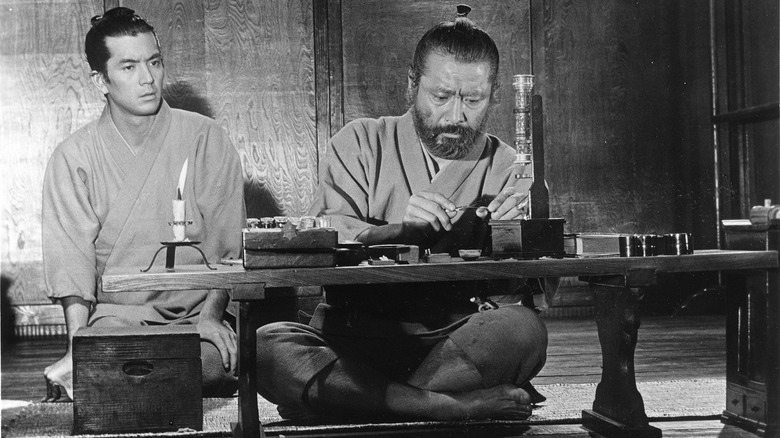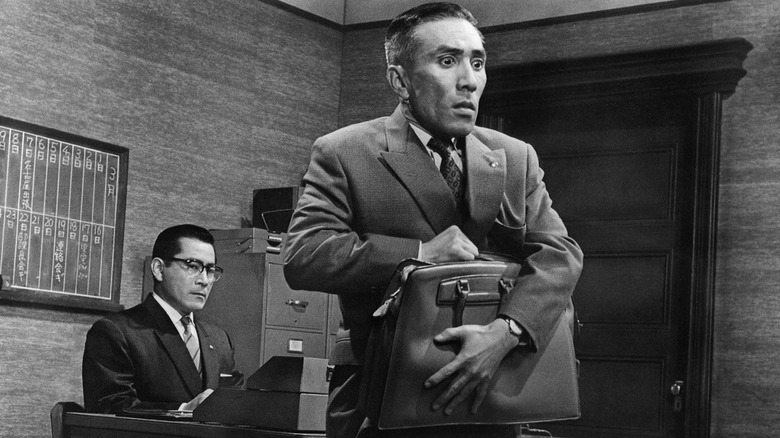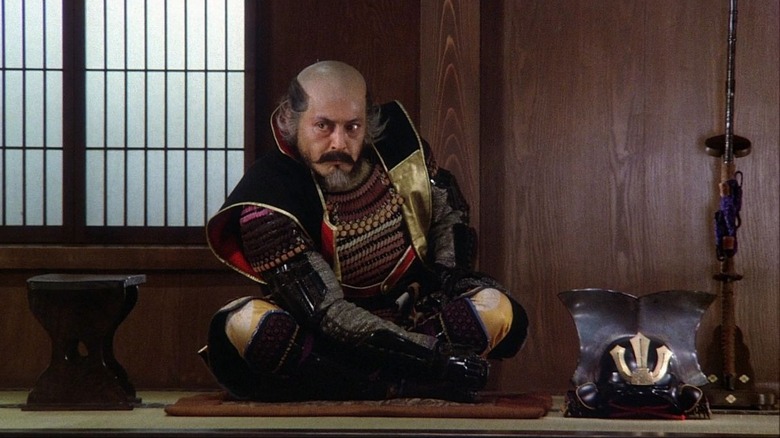Akira Kurosawa's Elaborate Sets Weren't Built Just To Look Good On Screen
Akira Kurosawa may be one of cinema's more humane filmmakers. While he did see a lot of sadness and injustice in the world, and would address those issues in his films, few of his works skewed full-bore into cynicism. Often, wicked characters would face retribution for their actions — seen most notably in Kurosawa's Shakespeare adaptations "Throne of Blood" (1957), "The Bad Sleep Well" (1960), "Kagemusha" (1980), and "Ran" (1985) — but more often, their moral fall was depicted as a great, tragic failing of the world. He looked and saw people, not archetypes. If one sees archetypes in Kurosawa movies, it's probably because he originated many of them. It was only with his outlandish Old West-inflected samurai films "Yojimbo" (1961) and its sequel "Sanjuro" (1962) that Kurosawa would allow himself to dip into his own version of adolescent misanthropy.
Because of his focus on the more human aspects of his movies, Kurosawa rarely bends full-bore into the fantastical or the artificial; "Throne of Blood" is his only film with out-and-out supernatural elements (the ghost in "Rashomon" was arguably the medium playacting) and his films only became more stylized and colorful ("Ran," "Dreams") late in his career. When Kurosawa worked with actors, he endeavored to keep their experience organic and natural, breaking down as much artificiality as possible.
This got Kurosawa in a small amount of trouble from time to time, as he was occasionally criticized for making his sets too big and elaborate. In his 1983 autobiography "Something Like an Autobiography," Kurosawa explained that it was his aim of connecting with actors that kept his set design as complicated as it was.
Kenji Mizoguchi
Kurosawa admits in his autobiography that he drew the notion of authentic sets from the masterful Kenji Mizoguchi, the director of "Osaka Elegy," "Ugetsu," "Sansho the Bailiff," "47 Ronin" and about a hundred others. Mizoguchi was only 12 years Kurosawa's senior, but was already prolific filmmaker and established cinematic presence throughout the 1920s. Kurosawa saw many Mizoguchi films in his youth, and took an important lesson from a fellow master:
"I am often accused of being too exacting with sets and properties, of having things made, just for the sake of authenticity, that will never appear on camera. Even if I don't request this, my crew does it for me anyway. The First Japanese director to demand authentic sets and props was Mizoguchi Kenji, and the sets in his films are truly superb. I learned a great deal about filmmaking from him, and the making of sets is among the most important."
Why is the making of sets the most important thing? Kurosawa further elaborates that it has everything to do with how actors move and feel when they're in authentic spaces.
The natural ease
It's worth noting that in the 1940s, Kurosawa was involved with numerous theater projects, including a one-act play called "Talking," as well as a stage adaptation of his film "Drunken Angel," which was produced during a notorious Toho strike. "Drunken Angel" starred Takashi Shimura and Toshiro Mifune from the movie. He also directed a production of Anton Chekhov's one-act play "A Marriage Proposal," evoking questions as to why Kurosawa didn't direct Chekhov more often.
Point being, Kurosawa was familiar with the dynamics of theaters and the immediacy of acting live on a real set. When expanding those notions to film, he simply inflated the intimacy of theater into the broader headspace afforded by cinema. In short, he liked letting his actors occupy a real space, cutting down on their need to project their environment around them:
"The quality of the set influences the quality of the actors' performances. If the plan of a house and the design of the rooms are done properly, the actors can move about in them naturally. If I have to tell an actor, 'Don't think about where this room is in relation to the rest of the house,' that natural ease cannot be achieved. For this reason, I have the sets made exactly like the real thing. It restricts the shooting, but encourages that feeling of authenticity."
A natural extension of his insistence on elaborate sets is that they look amazing to the audience. Watching an actor move from room to room gives Kurosawa's films a note of authenticity that a smaller set could not capture. He thought big, and his films felt big as a result, even if they were down-to-Earth and intimate.
25 of Kurosawa's movies are currently available to stream on the Criterion Channel.


